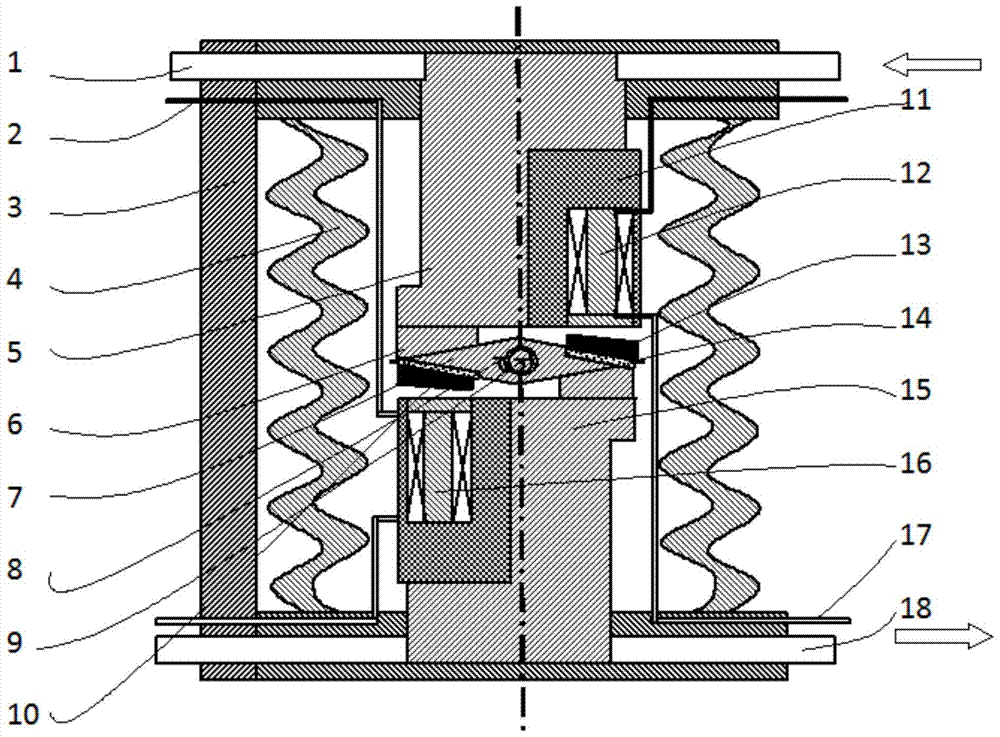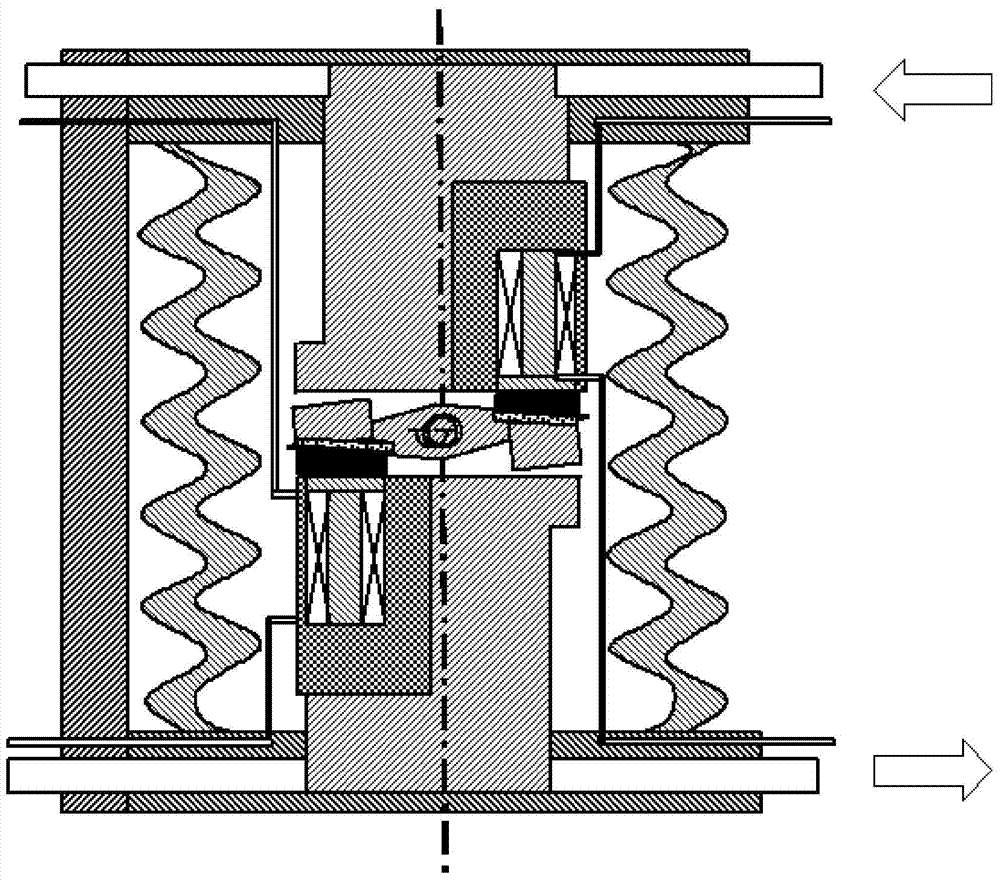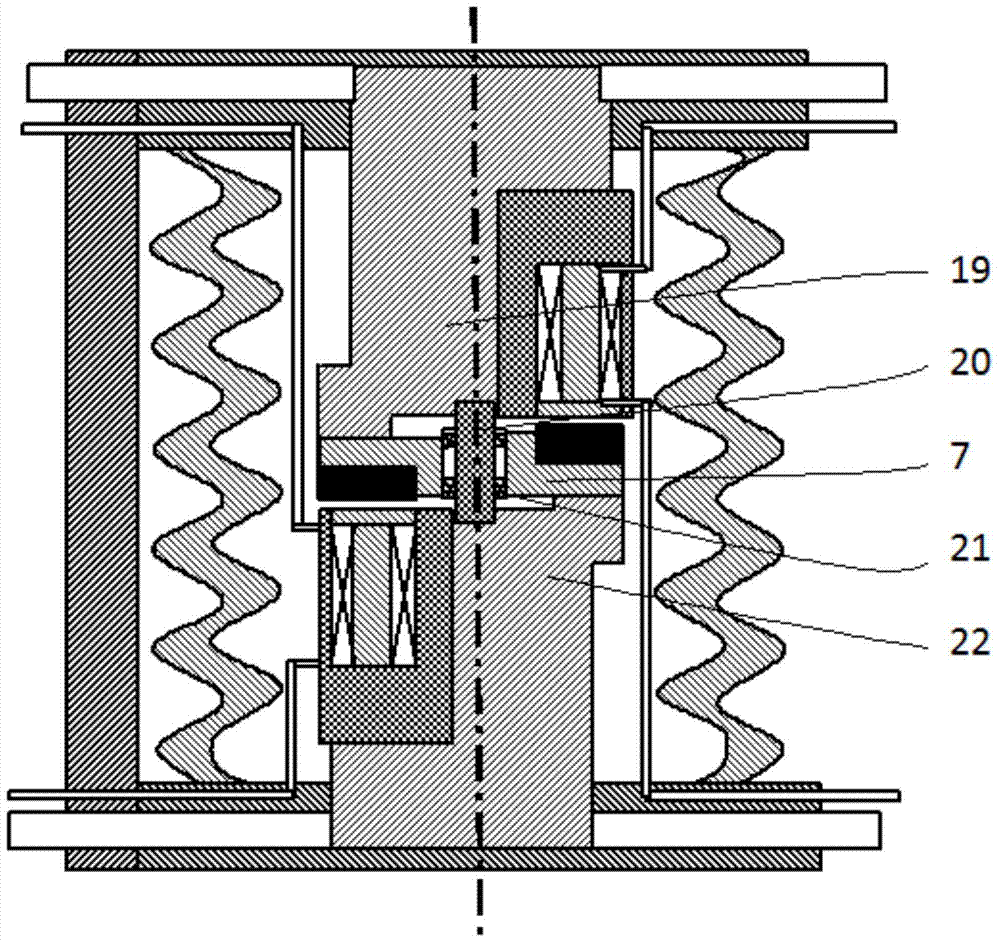Self-opening vacuum circuit breaker device
A vacuum circuit breaker, self-opening and closing technology, applied in the direction of high-voltage air circuit breakers, circuits, electric switches, etc., can solve problems such as accident-prone, easy-to-failure, complex structures, etc., to simplify the mechanical pull drive system and avoid opening Combined resistance, simple and compact structure
- Summary
- Abstract
- Description
- Claims
- Application Information
AI Technical Summary
Problems solved by technology
Method used
Image
Examples
Embodiment 1
[0076] Such as figure 1 As shown, this embodiment provides a self-opening and closing vacuum circuit breaker device, including a main current input electrode 1, an excitation current input electrode 2, a vacuum chamber, an upper electrode column 5, a lower electrode column 15, an excitation current output electrode 17, The main current output electrode 18 and the opening and closing control mechanism; wherein:
[0077] The opening and closing control mechanism includes an opening and closing mechanism and a control mechanism, the opening and closing mechanism is arranged between the upper electrode column 5 and the lower electrode column 15, and a control magnetic field is formed between the control mechanism and the opening and closing mechanism; the main The current input electrode 1 is connected to the outer end of the upper electrode column 5; the main current output electrode 18 is connected to the outer end of the lower electrode column 15; the excitation current input e...
Embodiment 2
[0102] Embodiment 2 is a modification example of Embodiment 1.
[0103] Such as image 3 As shown, the difference between embodiment 2 and embodiment 1 is:
[0104] The lower edge of the upper electrode column 5 is provided with an upper salient pole column 19;
[0105] The upper edge of the lower electrode column 15 is provided with a lower salient electrode column 22;
[0106] The opening and closing mechanism includes a rotating structure body 7, a first magnetic body and a second magnetic body. The rotating structure body 7 is a planar conductor structure, and a non-conductive rotating shaft 20 is provided at the center of the rotating structure body 7. The axis of the conductive rotating shaft 20 coincides with the axis of the upper electrode column 5 and the lower electrode. The rotating structure 7 can rotate around the non-conductive rotating shaft 20 between the upper electrode column 5 and the lower electrode column 15. The first magnetic body and the The second m...
Embodiment 3
[0111] Embodiment 3 is a modification example of Embodiment 1.
[0112] Such as Figure 5 As shown, the difference between embodiment 3 and embodiment 1 is:
[0113] The opening and closing mechanism includes a rotating sphere 24 with at least one magnetic body built in, and the rotating sphere 24 includes a rigidly spliced non-conductive structure 24022401 and a conductive structure 2402;
[0114] The control mechanism includes two electromagnetic coils (an upper large coil 23 and a lower large coil 25 ), and the two electromagnetic coils are respectively wound on the outside of the upper electrode column 5 and the lower electrode column 15 .
[0115] The working principle of this embodiment is:
[0116] The excitation current input electrode 2 inputs the excitation current to the electromagnetic coil, so that the electromagnetic coil generates an electromagnetic field, and forms a control magnetic field with the magnetic body built in the rotating sphere 24, and the magn...
PUM
 Login to View More
Login to View More Abstract
Description
Claims
Application Information
 Login to View More
Login to View More - R&D
- Intellectual Property
- Life Sciences
- Materials
- Tech Scout
- Unparalleled Data Quality
- Higher Quality Content
- 60% Fewer Hallucinations
Browse by: Latest US Patents, China's latest patents, Technical Efficacy Thesaurus, Application Domain, Technology Topic, Popular Technical Reports.
© 2025 PatSnap. All rights reserved.Legal|Privacy policy|Modern Slavery Act Transparency Statement|Sitemap|About US| Contact US: help@patsnap.com



